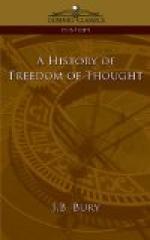[94] group were forced by the intolerance of Calvin to flee to Transylvania and Poland where they propagated their doctrines. The Unitarian creed was moulded by Fausto Sozzini, generally known as Socinus, and in the catechism of his sect (1574) persecution is condemned. This repudiation of the use of force in the interest of religion is a consequence of the Socinian doctrines. For, unlike Luther and Calvin, the Socinians conceded such a wide room to individual judgment in the interpretation of Scripture that to impose Socinianism would have been inconsistent with its principles. In other words, there was a strong rationalistic element which was lacking in the Trinitarian creeds.
It was under the influence of the Socinian spirit that Castellion of Savoy sounded the trumpet of toleration in a pamphlet denouncing the burning of Servetus, whereby he earned the malignant hatred of Calvin. He maintained the innocence of error and ridiculed the importance which the Churches laid on obscure questions such as predestination and the Trinity. “To discuss the difference between the Law and the Gospel, gratuitous remission of sins or imputed righteousness, is as if a man were to discuss whether a prince was to come on horseback,
[95] or in a chariot, or dressed in white or in red.” [1] Religion is a curse if persecution is a necessary part of it.
For a long time the Socinians and those who came under their influence when, driven from Poland, they passed into Germany and Holland, were the only sects which advocated toleration. It was adopted from them by the Anabaptists and by the Arminian section of the Reformed Church of Holland. And in Holland, the founder of the English Congregationalists, who (under the name of Independents) played such an important part in the history of the Civil War and the Commonwealth, learned the principle of liberty of conscience.
Socinus thought that this principle could be realized without abolishing the State Church. He contemplated a close union between the State and the prevailing Church, combined with complete toleration for other sects. It is under this system (which has been called jurisdictional) that religious liberty has been realized in European States. But there is another and simpler method, that of separating Church from State and placing all religions on an equality. This was the solution which the Anabaptists would have preferred. They detested the State; and the doctrine of religious liberty was not
[96] precious to them. Their ideal system would have been an Anabaptist theocracy; separation was the second best.




